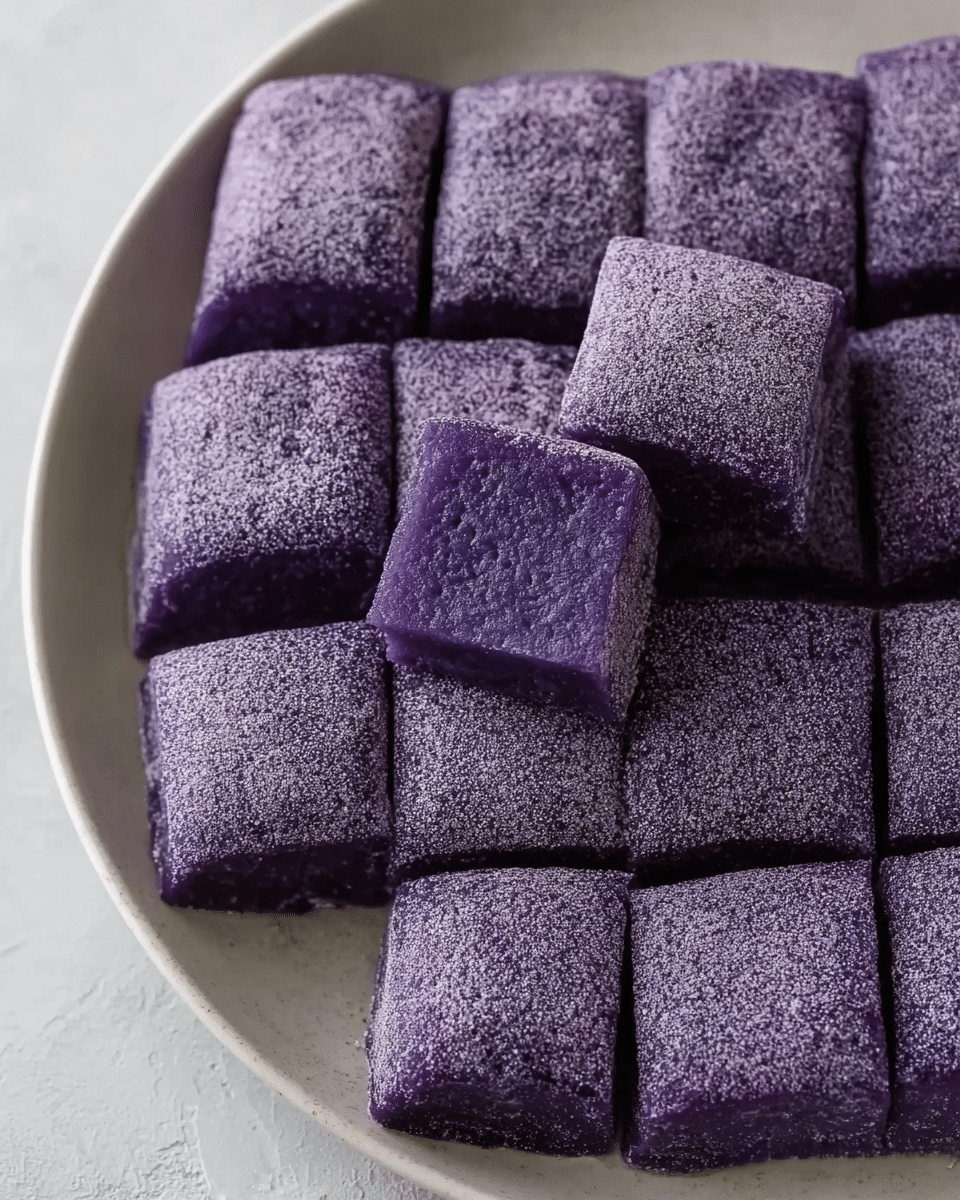Ube Mochi is a soft, chewy, and delightfully tropical dessert made with purple yam flavoring, coconut milk, and sweet rice flour. Inspired by the beloved Hawaiian Butter Mochi, this ube version brings a vibrant purple hue and unique flavor to the classic treat. It’s incredibly easy to make—just one bowl, less than 10 ingredients, and no special equipment needed. Perfect for potlucks, parties, or afternoon snacks, each bite is rich, slightly sweet, and satisfyingly chewy.
Full Recipe:
Ingredients
-
½ cup unsalted butter, melted and cooled slightly
-
1½ cups granulated sugar
-
4 large eggs, room temperature
-
2 tbsp ube extract
-
1 (16-oz) box Mochiko flour (or glutinous rice flour)
-
2 tsp baking powder
-
1 (12-oz) can evaporated milk
-
1 (14-oz) can coconut milk
Directions
-
Preheat oven to 350°F. Line a 9×13-inch baking pan with parchment paper and set aside.
-
In a large bowl, stir together melted butter and sugar until well combined.
-
Add eggs one at a time, mixing well after each addition.
-
Stir in ube extract until evenly blended.
-
Add Mochiko flour and baking powder; mix until about 80–90% combined.
-
Pour in evaporated milk and coconut milk, stirring until batter is smooth and lump-free.
-
Transfer batter to the prepared pan and bake for 45 minutes, or until a tester inserted in the center comes out with minimal dry crumbs.
-
Allow to cool completely in the pan before slicing into bars.
Nutrients (per bar – 36 bars)
-
Calories: 55 kcal
-
Carbohydrates: 8 g
-
Protein: 0.05 g
-
Total Fat: 3 g
-
Saturated Fat: 2 g
-
Polyunsaturated Fat: 0.1 g
-
Monounsaturated Fat: 1 g
-
Trans Fat: 0.1 g
-
-
Cholesterol: 7 mg
-
Sodium: 1 mg
-
Potassium: 24 mg
-
Fiber: 0.01 g
-
Sugar: 8 g
-
Vitamin A: 79 IU
-
Calcium: 11 mg
-
Iron: 0.03 mg
What Makes Ube So Special
Ube, native to the Philippines, has gained global popularity for its distinct taste and natural beauty. Its flavor is subtly sweet, with notes reminiscent of vanilla and pistachio, and a richness that pairs perfectly with creamy and coconut-based desserts. In mochi, ube adds depth while the purple color creates an immediate visual impact. The ube extract used in this recipe enhances both the flavor and the bold hue, ensuring every bite is as pleasing to the eye as it is to the palate.
The Mochi Texture Everyone Loves
One of the most satisfying aspects of ube mochi is its texture. Made with sweet rice flour, also known as Mochiko flour, the dessert bakes into a chewy, slightly elastic bite that’s tender yet substantial. Unlike other baked goods that may dry out after a day or two, mochi stays moist and bouncy for days, making it perfect for make-ahead desserts. The chewiness contrasts beautifully with the melt-in-your-mouth richness of butter and the creaminess of coconut milk, creating a multi-layered sensory experience.
A Simple, One-Bowl Dessert
Despite its impressive flavor and texture, Ube Mochi is remarkably easy to prepare. Everything comes together in one bowl without the need for a stand mixer, complicated folding techniques, or special baking pans. The straightforward process makes it approachable for beginner bakers while still satisfying seasoned cooks who appreciate a quick yet show-stopping dessert. Minimal cleanup is another bonus, especially when making large batches for events.
The Role of Coconut Milk and Evaporated Milk
The liquid ingredients in this recipe are key to its signature taste and texture. Coconut milk infuses the mochi with a mild tropical aroma and a velvety richness, while evaporated milk adds creaminess without excess sweetness. Together, they provide moisture that keeps the bars soft and chewy for days after baking. The combination also complements the nutty, vanilla-like notes of the ube, creating a flavor profile that’s comforting yet distinctive.
Why Butter Matters
Butter plays a subtle but essential role in this dessert. It lends a hint of savory richness that balances the sweetness and enhances the chewy texture. In Ube Mochi, butter’s flavor acts as the perfect bridge between the floral, nutty ube and the creamy coconut milk, preventing the dessert from becoming overly sweet or one-dimensional. It also helps create a slightly crisp edge while keeping the center tender.
A Dessert for Any Occasion
Ube Mochi’s charm lies in its versatility. It’s casual enough for an afternoon snack with coffee or tea, yet striking enough for festive occasions. The vibrant purple color makes it an excellent choice for birthdays, baby showers, and holiday dessert tables. In Hawaii, butter mochi is a potluck favorite, and this ube version is equally suited to sharing—easy to slice into neat squares or bars that hold their shape during transport.
How Ube Mochi Differs from Other Mochi Desserts
While mochi takes many forms across different cuisines, Ube Mochi stands out for being baked rather than steamed or pounded. Traditional Japanese mochi is made from glutinous rice that’s steamed and pounded into a smooth, sticky mass. Filipino ube desserts often feature ube halaya, a sweetened yam jam. Ube Mochi borrows from these traditions but bakes into a firm, sliceable treat that’s more like a cake in form but distinctly mochi in texture.
A Vibrant Addition to Dessert Spreads
Visually, Ube Mochi is stunning. The rich purple hue instantly draws attention on a dessert table, making it a natural conversation starter. This bold color doesn’t fade when baked, so the final presentation is as striking as the unbaked batter. Paired with its unique chewiness, it offers guests something different from standard cakes, cookies, or pastries, ensuring it’s remembered long after the event.
Storage and Make-Ahead Benefits
Another advantage of Ube Mochi is its storage life. It keeps well at room temperature for a couple of days in an airtight container and can be refrigerated for up to a week without losing its texture. The chewiness actually develops more fully a day after baking, making it a prime candidate for preparing ahead of time. For longer storage, it can be frozen and thawed at room temperature without significant changes in quality.
Pairing Ideas for Serving
Ube Mochi is delicious on its own, but pairing it with other flavors can elevate the experience. A dollop of lightly sweetened whipped cream adds airiness, while a sprinkle of toasted coconut enhances the tropical theme. Fresh fruit like mango or pineapple provides brightness, and for a more decadent approach, a drizzle of white chocolate works beautifully with the purple color. Beverages such as jasmine tea, iced coffee, or even a coconut latte make excellent companions.
Customizing for Personal Taste
While the base recipe is wonderfully balanced, there’s room for personalization. Adding shredded coconut to the batter provides extra texture, while incorporating a swirl of ube halaya intensifies the yam flavor. For a slightly different look, the top can be sprinkled with sesame seeds before baking, adding a subtle nutty crunch. Adjusting the sweetness to taste is easy, too—slightly reducing the sugar still yields a flavorful result thanks to the richness of the other ingredients.
A Treat That Bridges Cultures
Ube Mochi is more than just a dessert—it’s a cultural bridge. It merges elements of Filipino cuisine (ube’s flavor and color) with Hawaiian comfort food (butter mochi’s chewy baked form) in a way that feels seamless. This blending of influences is part of what makes the dessert so appealing to a wide audience. It tells a story of shared flavors and evolving traditions, proving that food can be both rooted in heritage and open to reinterpretation.
Why It’s Becoming a Modern Favorite
In recent years, ube has surged in popularity worldwide, appearing in everything from lattes to ice cream. Ube Mochi benefits from this trend, offering a way to enjoy the flavor in a format that’s approachable and easy to share. Its unique color makes it highly Instagram-worthy, while its satisfying chewiness keeps people coming back for more. This combination of visual appeal, taste, and texture is why it’s becoming a modern favorite among both home bakers and professional pastry chefs.
Conclusion
Ube Mochi is the perfect example of a dessert that’s as beautiful as it is delicious. With its striking purple color, chewy yet tender texture, and rich, nuanced flavor, it’s a standout treat for any occasion. Easy to prepare, versatile to serve, and simple to customize, it offers both convenience and creativity for bakers of all levels. Whether you’re introducing someone to ube for the first time or sharing it with lifelong fans, this dessert delivers an experience that’s memorable in every bite. From its tropical roots to its universal appeal, Ube Mochi is a recipe that deserves a permanent spot in your collection—a sweet, chewy reminder of how delightful blending cultures and flavors can be.






